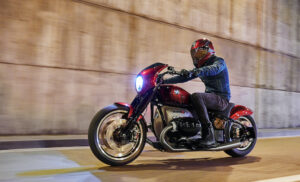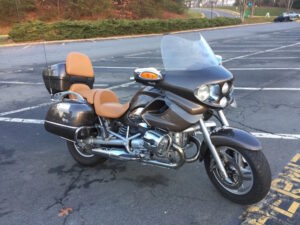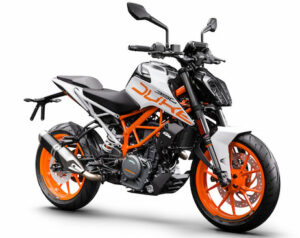It started in December 2018. “Did you see this?” BMW fans breathlessly exclaimed on Facebook. “Is it really a BMW?” they asked. “It can’t be – but look at it! Maybe it could be.”

The Custom Works Zon motorcycle called the Departed, which made its debut at the Hot Rod Custom Show in Yokohama, Japan, looked like a café racer built around a near-lethal mix of steroids and meth, fueled by a steady diet of coffee and cigarettes. The unbelievably big wheels (21” front, 26” rear) coupled with equally unbelievably low-profile tires and that open drive shaft made us all shudder.
Then we noticed the engine. That beautiful, unbelievably big engine. BMW Motorrad was scarce with details at first, but we soon found out the engine was an 1800 CC behemoth, the biggest bore ever found in BMW’s iconic boxer twin. Unlike the super-modern, cam-shifting liquid-cooled 1250 BMW announced earlier in 2018, the Departed’s engine was air cooled with external push rods that made it look straight out of the 1960s BMW catalog.

After four months of chatting about the Departed and speculating just what BMW might be up to, Revival Cycles released the Birdcage, another one-off bike featuring the beastly boxer engine, displaying it at the Handbuilt Show in Austin, Texas. Where the Departed looked like solid muscle, the Birdcage played off the concept of negative space, taking the idea of a trellis frame to an illogical extreme and throwing racing slicks on a solid rear wheel – but maintaining the open drive shaft look.
As with the Departed, the Birdcage gave us visual ecstasy, but no details on the engine. BMW kept its mouth shut as well. Other than the displacement, we knew nothing. Speculation about the Big Boxer continued to grow. With two radically different custom bikes in existence, the only thing anybody could agree on was BMW seemed to be making more than just one of these engines.

A month after we saw the Birdcage, BMW Motorrad chose the Concorso d’Eleganza Villa d’Este in Cernobbio, Italy, to show off its in-house-built Concept R 18. BMW Motorrad Head of Design Edgar Heinrich said, “The Concept R 18 embodies…what motorcycling, at its core, is really about. It’s about feeling instead of thinking.”
With chrome, shiny black paint and gold pinstripes all on prominent display, discussions immediately turned to the Concept 101, the “touring cruiser” built around the inline six cylinder engine that powers the K 1600 line. After debuting the Concept 101 at the Concorso d’Eleganza in May 2015, BMW announced the production version, known as the K 1600 B (for bagger), in October 2016.
When BMW Motorrad said they were planning on putting the 1800 CC engine into a production motorcycle, those of us who remembered the Bagger immediately started looking at calendars. If BMW was able to adhere to the same timeline, we might see an actual R 18 production motorcycle in dealerships in summer 2021. Baggers hit the dealerships in summer 2018, barely three years after the Concept 101 debuted, after all. BMW jumped in almost immediately, saying a bike built around the R 18 engine would be out some time in 2020.

Anticipation and criticism of the bike cropped up in numerous conversations, sometimes even without my having to bring the bike up first. The biggest ding against the R 18 seemed to be its throwback styling plus mid-forward controls. Retro bikes are hot, we can see that by looking at the astronomically successful Triumph Bonneville and BMW’s own popular retro bikes, the R nineT Heritage series.
Still, we all remember the R 1200 C. More importantly, we also remember the R 1200 CL.
What we remember about those chromeheads is they were underpowered and sold poorly, disappearing after just a seven-year run despite BMW’s attempts at promoting them and making them more appealing to riders by releasing variations such as the Avantgarde, Phoenix and Montauk. We can argue about the C/CL being underpowered all day long, but the core of that argument stems from people expecting the engine to be a typical BMW boxer of the day rather than an engine meant to be in a cruiser.
The R 1200 C and the touring CL/CLC versions were BMW’s first real attempt at designing a bike from the ground up meant to appeal directly – and possibly uniquely – to US riders. BMW’s head designer at the time, David Robb, said the C was “designed to portray both a laid back cruiser stance and also showcase BMW’s technical sophistication.” Despite gaining worldwide attention by appearing in the 1997 James Bond movie Tomorrow Never Dies and surviving an improbable two-up jump, the C just didn’t sell in enough quantity to keep it in the lineup.

The CL/CLC variants were even less successful, as adding a full suite of hard cases and a large fork-mounted fairing with an unusual four-light setup did nothing to boost sales. In the interests of full disclosure, I owned a 2004 R 1200 CLC and yes, it was a BIG bike and ungainly in parking lots due to the bike’s weight, the fairing and the fat front tire. However, get it out on the highway, start chasing the horizon, shift through the gears as you gradually come up to highway speeds, then engage the cruise control and it was perhaps one of the best touring motorcycles BMW has ever built. It required patience, attention to acceleration and shifting, not things usually at the top of a motorcycle rider’s list.
I think we can all agree that metallic brown color BMW painted some of the CLs was something only a designer could love, one of a number of things that made it even less appealing to the apparently cruiser-loving American riding public. Never mind it sported performance figures roughly the same as a premium Harley at the time – BMW riders tended to shun the C/CL because those bikes just weren’t what riders expected a BMW to look, sound or perform like.
Similar to the C/CL engine in 2000, the R 18 in 2020 sports performance figures comparable to today’s big air-cooled cruisers being put on the street by Harley-Davidson and Indian. BMW claims the Big Boxer produces 91 horsepower and 117 pound-feet of torque at the crank. Expect those figures to drop by about 10% at the rear wheel. Harley claims their “Milwaukee 8” 114 (1868 CC) puts out 122 pound-feet of torque. Indian says their “Thunder Stroke” 111 (1819 CC) puts out 110 and we can expect their updated 116 in the 2020 models to best that by at least 10%. In other words, the R 18 Beastly Boxer is currently allegedly going to perform the same as US-built big cruisers and baggers that, while popular in American culture, continue to sell in ever-dwindling numbers despite the ongoing availability in the US of long, wide-open stretches of roads and plentiful gas stations.

Despite enjoying a sizable jump in production in 2017, BMW Motorrad’s numbers remain disappointing. Everybody knows motorcycle sales haven’t recovered to pre-Great Recession levels, but the whole market continues to struggle as motorcycle manufacturers flail, seemingly helpless in the face of the rising generations of Millennials and Gen Zs who simply aren’t as interested in motorcycles as Baby Boomers and Gen Xers are. Bicycle sales are similarly in the proverbial toilet, and if little kids aren’t crazy about bicycles, the chance of them developing an affinity for motorcycles lies somewhere between slim and none.
BMW’s sales figures are getting worse every year in the USA. BMW issue their 2019 annual report in the first quarter, and many industry analysts (including this one) expect to see two trends continue: First, that BMW’s sales will continue to fail to meet BMW’s pronouncements, and second, that US motorcycle sales will continue to decline.
There was a time when US sales were second only to Germany, with BMWs sold in North America making up a double-digit percentage of overall sales. That time has ended; US sales made up just 8.4% of worldwide BMW motorcycle sales in 2018 and the US ranked fourth in the world behind Germany, France and Italy. The sad thing about that is the population of Germany, France and Italy combined is just two-thirds of the population of the United States, and BMW sells more bikes in each of those countries than in the US!
We expect BMWs to sell well in Germany, but France and Italy? Italy is especially surprising given that country’s history of beautiful high-performance motorcycle production. Granted, Ducati’s worldwide production in 2018 was a little under one-third of BMW’s, and Ducati only sold about 8,000 bikes in the US the same year, about 60% as many as BMW sold in the US.
BMW Motorrad Sales 2014-18
| Year | Total Production | US Sales | US Rank | Pct of Sales |
| 2018 | 162,687 | 13,842 | 4 | 8.4% |
| 2017 | 185,682 | 13,546 | 4 | 8.3% |
| 2016 | 145,555 | 13,730 | 2 | 9.5% |
| 2015 | 151,004 | 16,501 | 2 | 12% |
| 2014 | 133,615 | 15,301 | 2 | 12.4% |
It’s reasonable to assume BMW is trying to find a way to get the lucrative US market back into the number 2 spot, thus the R 18. It’s also reasonable to think BMW is looking for ways to diversify their US sales because the adventure bike market surely isn’t going to last forever, and face it, BMW riders (especially in the US) buy more GS motorcycles than anything else – thus the R 18.
The US is a well-known market for cruisers and baggers, which is why BMW sent us the K 1600 B and the Grand America, both of which are fantastic motorcycles that aren’t selling in huge numbers. From a certain perspective, playing up the retro styling angle of the R 18 will be a big benefit, as the K 16 B/GA are more futuristic looking than anything BMW will be putting the 1800 CC engine into. BMW is spending a lot of effort pushing the 1960s throwback appeal of the R 18 and R 18/2, mentioning it every chance they get.

It’s hard to say if the R 18 will have enough retro appeal to get Gen Xers to come up with what is likely to be at least $25,000 to buy one. I don’t see a lot of Boomers buying them – the older we get, the less appealing heavy cruisers become simply because of their weight. There’s a reason Harley is coming out with an adventure bike, and it’s not because sales of their high-end cruisers and baggers are continuing to climb. Indian came out with what is effectively a street-legal flat track racer, the FTR 1200. Both Indian and Harley recognize they need to diversify their offerings to build market share. BMW seems to recognize this as well, but with the R 18, they may be diversifying in the wrong direction.

Other manufacturers are coming out with lightweight, single-cylinder sport and adventure bikes. BMW’s G 310 R and GS have quietly escaped our attention, already dropping off the radar despite a big press push upon their initial release. Still others are creating a slew of parts bin bikes – Triumph, for example – effectively turning one platform into a half-dozen or more models, all of which have their own niche appeal. The R nineT fills this approach for BMW, but with ever-tightening European emissions regulations, the plain air/oil-cooled engine is not long for this world.
It remains to be seen whether the appeal of 50-year-old styling with 20-year-old engine design and modern technology like throttle by wire, cruise control, ABS, LED lighting and traction control will be what it takes to boost BMW’s motorcycle sales in the USA. One thing is for sure – I’ll be getting my hands and feet on an R 18 as soon as is humanly possible, and I’m hoping it’s everything I expect it to be and more.
